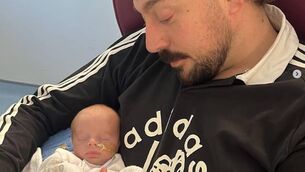Pete the Vet: Could your dog have thyroid disease?

Pete the Vet: Hypothyroidism typically develops in older dogs, and medium to large breeds are more likely to be affected, like Irish Setters.
Thyroid hormones are an important part of the mammalian metabolism, shared by humans, dogs and cats alike. The hormones are produced by the thyroid gland, a butterfly-shaped structure with a pair of bean-like nodules, one on the left and one on the right on either side of the upper part of the windpipe. Thyroid hormones regulate the speed of the metabolism, similar to the accelerator pedal in a car.
In most humans, and most animals, precisely the correct amount of thyroid hormone is produced. Most people and pets motor along at around the right speed, neither stuttering and stalling with inadequate quantity of hormone, nor speeding wildly along with excessive hormone in our systems.
However, abnormalities of thyroid hormone production are surprisingly common. In humans, both excessive thyroid hormone production (hyperthyroidism) and insufficient thyroid hormones (hypothyroidism) are seen with similar frequency.
In pets, there’s a species-specific difference. Dogs are far more likely to suffer from an underactive thyroid gland, with hypothyroidism affecting 0.2 - 0.8% of the population, while hyperthyroidism is vanishingly rare.
In contrast, cats almost never develop hypothyroidism (there are only three documented cases in the literature) while hyperthyroidism is very common, affecting 3% of the general population, or over 10% of cats over the age of ten.
It makes sense that dog owners should know the basics of underactive thyroid glands, while cat owners should know what to look out for if their pet has overactive thyroid glands.
Let’s start with dogs with hypothyroidism, or an underactive thyroid gland. In 95% of cases, this is caused by destruction of the thyroid gland either as a result of an auto-immune type condition where the immune system seems to attack its own gland (lymphocytic thyroiditis) or the gland just withers away for reasons that we don’t yet understand. The other 5% of cases happen when rare cancers develop, or some dogs are just born with inadequate thyroid glands.
Hypothyroidism typically develops in older dogs, and medium to large breeds are more likely to be affected, including Cocker Spaniels, Dachshunds, Dobermans, Golden Retrievers and Irish Setters.
Typical signs that an owner might notice include lethargy, exercise intolerance, weight gain without a change in appetite, obesity and a preference for warmer parts of the home. Changes in the coat and skin are often seen, including increased moulting, thinning of the hair, and areas of baldness, as well as coat colour changes.
The good news is that this condition is easily treated with a daily hormone supplement, and all of the listed changes will return to normal. However the challenge is making the diagnosis: in some cases, a simple blood test to measure the thyroid hormones is enough, but there are many cases where the blood test results are borderline.
A series of more specialised tests is then needed to try to gain a more in depth understanding of what’s going on with the thyroid hormones.
Occasionally, vets and owners become frustrated with the lack of a confirmed diagnosis, and trial treatment with thyroid hormones may be given. This is far from ideal, but it can be an understandable approach for some cases: if the signs resolve with treatment, then with hindsight, the dog probably did have hypothyroidism.
In cats, hyperthyroidism is so common in older animals that testing the thyroid hormone levels is often a part of the “minimal database” that vets recommend when carrying out general health assessments on any sick older cat.
The cause in over 98% of feline cases is a benign tumour of one side of the thyroid gland: far more rarely, a malignant tumour may be involved. Although the cause of these tumours remains unknown, possible contributing factors include deficiencies or excesses of certain compounds in the diet and chronic exposure to thyroid-disrupting chemicals in food or the environment. Research is continuing into this, as it seems to be one of these “modern day” illnesses that has become more common in recent years.
A typical hyperthyroid case presents as an old, bright cat which is losing weight despite eating voraciously. A surprising number of owners think that their elderly pet is losing weight because of that vague condition known as “old age”. A visit to their local vet for a physical check up and an in-house blood test is often all that’s needed to demonstrate that the cat has excessive thyroid hormone levels that are causing their metabolism to run far faster than normal, burning up their food too quickly and causing the weight loss and ravenous appetite.

Other signs of the condition include vomiting and diarrhea, and an increased thirst and more urination. The cat’s coat sometimes appears unkempt, matted, or greasy.
The good news is that once the diagnosis has been confirmed with a blood test, highly effective treatment is available, and these elderly, scraggy, thin cats can easily be brought back to the full, hearty health that they previously enjoyed.
There are different treatment options, each with pros and cons.
The simplest answer is daily anti-thyroid medication (liquid or tablets), given with the food. There are also two permanent cures: either surgery to remove the benign tumour completely, or radiation treatment to destroy the tumour (this is only carried out at UCD in this country). Finally, for indoor cats whose dietary intake can be meticulously controlled, a specialised diet (ultra low in iodine) can be given instead of normal food to reduce thyroid hormone production.
Whether too much or too little hormone is in your pet’s bloodstream, the good news about thyroid problems in pets is that they can be successfully treated and effectively cured.







